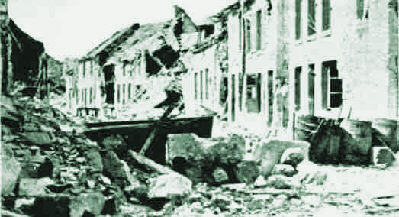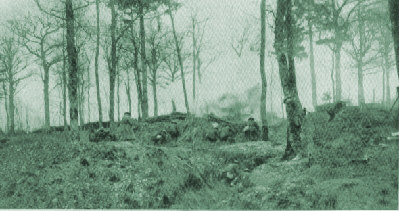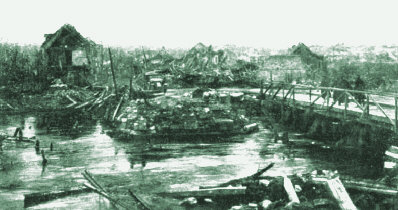These are official reports of this incident and have the coldness of such documents with a sprinkling of CYA. For a personal and chilling account of this American defeat, read Hervey Allen's great memoir, Toward the Flame. This affair is one of the reasons the emblem of the 28th Pennsylvania National Guard Division became known as the "Bloody Bucket." A memorial bridge built by the Commonwealth of Pennsylvania now stands across the River Vesle connecting the two villages discussed here.
Extract from III Corps History
Enemy Attack Against Fismette
27 August 1918
I. SITUATION: On the night of August 26/27, 1918, the village of FISMETTE was held by Companies G and H, 112th Infantry. These two companies totaled six officers and 200 men. This garrison relieved the previous garrison at 2 a.m. August 27.
II. OPERATION: At 4 a.m. on the same day a heavy enemy barrage was placed in and around the town of FISMETTE. After 20 minutes the barrage lifted and the enemy attacked with a force estimated at about one battalion. The attacking troops were evidently picked troops, being referred to in the German communiqué as "Baden troops." The attacking forces were apparently divided into three columns, one attacking from the northeast. another from the northwest, and the third from the north of the town. The attack followed immediately upon the lifting of the heavy bombardment, and caught our troops while they were more or less demoralized as a result of same. The platoon occupying the east edge of the lawn put up a good resistance. but the platoons to the north and west gave way with feeble resistance ante. resulting in the enemy practically enveloping the remaining defenders on the lawn, some of whom escaped to the south and crossed the VESLE. The enemy attack was accompanied by low-flying airplanes, which dropped bombs and fired machine guns. There is a report that a soldier in an American uniform ran through the streets shouting that the lieutenant in command said resistance was useless and had ordered his men to surrender. It is not definitely settled as to whether or not this man was an American soldier or any enemy in disguise.
III. RESULT: The result of the enemy operation was the loss of the village of FISMETTE by our troops and the loss of four officers and 161 men missing. These figures include our killed and wounded as well as prisoners who were left in the village when it was captured.
IV. CONCLUSION: The following conclusions are drawn:
(1) The attack, following immediately after relief, caught our troops before they had become familiar with the positions occupied.
(2) The possibility of utter demoralization caused by an enemy in our uniform or a cowardly soldier of our own creating a panic among our men.
(3) Our troops apparently assumed that the bombardment was a usual one, and consequently were not on the alert to repel an attack.
(4) There was culpable negligence in not requesting artillery support.
(5) There was not the spirit among the garrison holding the west and north of the town to fight to the last man.
(6) The effectiveness of accompanying even a local attack by airplanes is shown. It is not so much a question of actual damage done by the airplane, but its effect upon the morale of the troops attacked.
(7) Our defensive organization of the village itself was doubtless faulty, as no provision was made for the defense of the village in case flank attacks should occur. And no provisions were made to properly deploy our machine guns and rifle fire for the protection of the rear and flanks of the platoons in position.

Streets of Fismette
From: Capt. Withers, 28th Division
To: G-3, III Corps
Telephone message from 112th Inf. to 28th Division.
Received at 28th Div. at 10:15 hrs, 27 August 1918.
Absolutely unable to get patrols into FISMETTE. Got down as far as 100 yards from bridge. Streets of FISMES running north and south covered by machine-gun fire and one-pounders. Two casualties in one patrol of six men. REIMS Road covered with machine-gun fire from left. Noticeable absence of flares. FISMETTE very quiet. No firing on FISMETTE since 1000 hrs., August 27. If there any of our men in FISMETTE they are very few and scattered and in hiding. No evidence to confirm any of our men holding out. Will make further reconnaissance. We still control FISMES down to the river and we are constantly patrolling river front along entire front of sector. Relief of machine gun companies complete. Stokes mortars and one-pounders are in position.
Action at Fismette
III ARMY CORPS, AEF,
A. P. 0. 754, August 28, 1918.
General J. W. McAndrew.
G.H.Q., A.E.F.
My dear General:
I am informed that today's German communiqué (which I have not seen) states that the Germans captured FISMETTE yesterday and 250 Americans. A part of my command until yesterday occupied FISMETTE. I had there some 190 officers and men altogether, infantry, If you will look upon the map you will see the position of FISMES, a large village on the south bank of the VESLE. Just opposite FISMES on the north bank is the small village of FISMETTE. The village of FISMETTE and no more was occupied by us. Ten days ago, after a German attack upon FISMETTE which almost succeeded, I saw that FISMETTE could not be held by us against any real attempt by the Germans to take it and that to attempt to continue to hold it would, on account of the lay of the surrounding terrain. involve the sure sacrifice of its garrison. Help could not be sent except by driblets at night.
I, therefore. decided and began to withdraw the garrison of FISMETTE some 300 meters back across the VESLE River into FISMES. Before this was finished the French General commanding the Sixth Army, to which I belong, arrived at my headquarters and learning of my orders for withdrawal from FISMETTE himself, in person, directed me to continue to hold FISMETTE and how to hold it. My orders were changed in his presence and his orders were obeyed. Yesterday morning the Germans made a strong attack upon FISMETTE from two directions, taking the village and killing or capturing almost all of our men.
I request that the Commander-in-Chief be acquainted with the facts in this case.
R. L. BULLARD.
Major General. N.A.
Commanding III Army Corps.

Advancing on the North Side of the Vesle
The Fismette and the north bank of the Vesle were finally secured by the AEF on the night of 3-4 September 1918.
Read more on the actions of the AEF in France at our Doughboy Center Website:
|





No comments:
Post a Comment